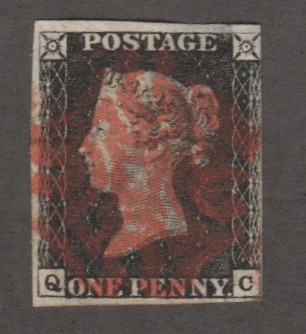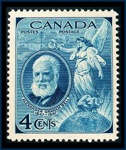
Discussion - Member to Member Sales - Research Center

Discussion - Member to Member Sales - Research Center


03:54:45pm

Login to Like
this post
I don't have any Sherms in my National album, I got a bunch of them in a stock book. I look at the vending and affixing machine perfs kind of bunched in with pre-cancels and perfins. Still very interesting issues

Login to Like
this post
Personally, I created a page for examples of third party perforations because I prefer the unaltered imperforates for the main pages.

However, the Second Bureau is a place where third party perforations may be the only hope as surrogates for rare coils.
The coils issued by BEP in the Second Bureau were: One cent horizontal and vertical, two cent horizontal and vertical, and five cent horizontal perf (see Scott catalog for details - 316-318, 321-322). The CV for those five stamps is $299,000. However, it may still be possible to reasonably represent Second Bureau coils through Third Party perforations of imperforate sheets (see Vending & Affixing Machine Perforations in the Scott Specialized Catalog). Thus far, I have decided NOT to do this, but I may change my mind. Here is how it could be done:
One cent coil perforated horizontally (CV $55,000) represented by Brinkerhoff Type II perforations $12.50 for a used single; $75 for an unused pair
One cent coil perforated vertically (CV $6,000) represented by Schermack Type III perforations $2.25 for a used single; $11.00 for an unused pair
Two cent coil (Type I) perforated horizontally (CV $225,000) represented by Brinkerhoff Type II perforations $12.50 for a used single; $37.50 for an unused pair
Two cent coil (Type II) perforated vertically (CV $7,000) represented by Schermack Type III perforations $2.75 for a used single; $22.50 for an unused pair
Five cent coil perforated horizontally (CV $6,000) represented by U.S. Automatic Vending Company Type I $750 for an unused pair ($2000 for used single)
Obviously the five cent value is the challenge, and no wonder since it wasn't issued imperforate until 1908, the same year the Third Bureau was introduced.
Scott #314A is a special case (CV $45,000). The 4 cent Second Bureau stamp was never issued imperforate, or as a coil, to the public. As such, it is a bit of an oddity that is easily excluded.
Other than that, I haven't given it much thought. 
Lars
NOTE: I did this analysis years ago from a 2008 catalog so the prices are likely somewhat out of date.

Login to Like
this post
I see it completely the opposite way! The private perforations are an important part of our postal history. Pretty much the story of the beginnings of mail automation.
The imperforated stamps were created by the post office department at the request of companies that were developing postage vending and affixing equipment for the express purpose of modifying them to work in the equipment they were inventing.
The imperf sheets were never offered to the general public as a normal public issue. You didn't walk up to a postal counter in a rural post office and buy them. I believe at the request of the collecting community, they were sold through the main post office philatelic unit to dealers, who then distributed them to collectors. So all the imperf stamps with scissor cut edges, the blocks, arrow blocks, plate blocks etc. are all collector manufactured souvenirs.
So if indeed you wanted to collect these stamps as the post office department intended, you would want to have a stamp with private perforations in your collection versus one with perfect cut edges.
If you want a real collecting challenge, collect them used on cover. The early ones are impossible to find, other than on collector created covers!

Login to Like
this post
Tom,
I'm glad you weighed in with a different perspective. I created a page with examples precisely because it's an important part of postal history. I can see how you reached your conclusion and I agree with just about everything you said (other than the conclusion, of course), but there was one thing that raised an eyebrow:
"So if indeed you wanted to collect these stamps as the post office department intended"
I find that perspective fascinating! I have always viewed my collection through the lens of the individual collector of the day. Your perspective certainly is a better explanation for why 314A was given a major catalog number. Interesting.
Lars

Login to Like
this post
BTW,
I think THIS is how the POD "intended" us to get these 3rd bureau imperfs:



Login to Like
this post
Back when I had a bunch! I think, therefore I am - I think! Descartes, sort of!
15 Apr 2020
03:54:45pm
I have a question. I just bought a great selection of Schermack coils(?) on SoR. I think they are fantastic, but exactly how do you classify them? They were all constructed from Imperforate stamps so do I think of them as a coil or an imperforate stamp that has been altered. What if I had a Schermack version of an Imperforate stamp I am missing? Could I safely put this in my album as #383, for example, or should I look for the "un-Schermack" version. I know what you are probably thinking, "do what you want, it's your collection"! But what would you do? The Schermacks are not given separate numbers as in, say 383sc, so obviously Scott's considers the Schermack to be the same as the imperforate. If I am talking to a serious US collector here, what would you do? By the way, I started a separate section for Schermacks rather than mix them in with the regular stamps. To me they are not the same as the stamp they came from and should be numbered as different. Do any of the other catalogs do that? Also most people seem to collect them as pairs, to me singles are fine.

Login to Like
this post

re: Imperforate or Schermack?
I don't have any Sherms in my National album, I got a bunch of them in a stock book. I look at the vending and affixing machine perfs kind of bunched in with pre-cancels and perfins. Still very interesting issues

Login to Like
this post

re: Imperforate or Schermack?
Personally, I created a page for examples of third party perforations because I prefer the unaltered imperforates for the main pages.

However, the Second Bureau is a place where third party perforations may be the only hope as surrogates for rare coils.
The coils issued by BEP in the Second Bureau were: One cent horizontal and vertical, two cent horizontal and vertical, and five cent horizontal perf (see Scott catalog for details - 316-318, 321-322). The CV for those five stamps is $299,000. However, it may still be possible to reasonably represent Second Bureau coils through Third Party perforations of imperforate sheets (see Vending & Affixing Machine Perforations in the Scott Specialized Catalog). Thus far, I have decided NOT to do this, but I may change my mind. Here is how it could be done:
One cent coil perforated horizontally (CV $55,000) represented by Brinkerhoff Type II perforations $12.50 for a used single; $75 for an unused pair
One cent coil perforated vertically (CV $6,000) represented by Schermack Type III perforations $2.25 for a used single; $11.00 for an unused pair
Two cent coil (Type I) perforated horizontally (CV $225,000) represented by Brinkerhoff Type II perforations $12.50 for a used single; $37.50 for an unused pair
Two cent coil (Type II) perforated vertically (CV $7,000) represented by Schermack Type III perforations $2.75 for a used single; $22.50 for an unused pair
Five cent coil perforated horizontally (CV $6,000) represented by U.S. Automatic Vending Company Type I $750 for an unused pair ($2000 for used single)
Obviously the five cent value is the challenge, and no wonder since it wasn't issued imperforate until 1908, the same year the Third Bureau was introduced.
Scott #314A is a special case (CV $45,000). The 4 cent Second Bureau stamp was never issued imperforate, or as a coil, to the public. As such, it is a bit of an oddity that is easily excluded.
Other than that, I haven't given it much thought. 
Lars
NOTE: I did this analysis years ago from a 2008 catalog so the prices are likely somewhat out of date.

Login to Like
this post

re: Imperforate or Schermack?
I see it completely the opposite way! The private perforations are an important part of our postal history. Pretty much the story of the beginnings of mail automation.
The imperforated stamps were created by the post office department at the request of companies that were developing postage vending and affixing equipment for the express purpose of modifying them to work in the equipment they were inventing.
The imperf sheets were never offered to the general public as a normal public issue. You didn't walk up to a postal counter in a rural post office and buy them. I believe at the request of the collecting community, they were sold through the main post office philatelic unit to dealers, who then distributed them to collectors. So all the imperf stamps with scissor cut edges, the blocks, arrow blocks, plate blocks etc. are all collector manufactured souvenirs.
So if indeed you wanted to collect these stamps as the post office department intended, you would want to have a stamp with private perforations in your collection versus one with perfect cut edges.
If you want a real collecting challenge, collect them used on cover. The early ones are impossible to find, other than on collector created covers!

Login to Like
this post

re: Imperforate or Schermack?
Tom,
I'm glad you weighed in with a different perspective. I created a page with examples precisely because it's an important part of postal history. I can see how you reached your conclusion and I agree with just about everything you said (other than the conclusion, of course), but there was one thing that raised an eyebrow:
"So if indeed you wanted to collect these stamps as the post office department intended"
I find that perspective fascinating! I have always viewed my collection through the lens of the individual collector of the day. Your perspective certainly is a better explanation for why 314A was given a major catalog number. Interesting.
Lars

Login to Like
this post

re: Imperforate or Schermack?
BTW,
I think THIS is how the POD "intended" us to get these 3rd bureau imperfs:



Login to Like
this post

